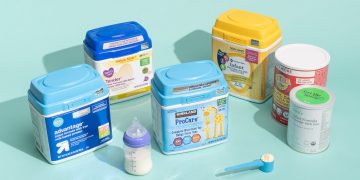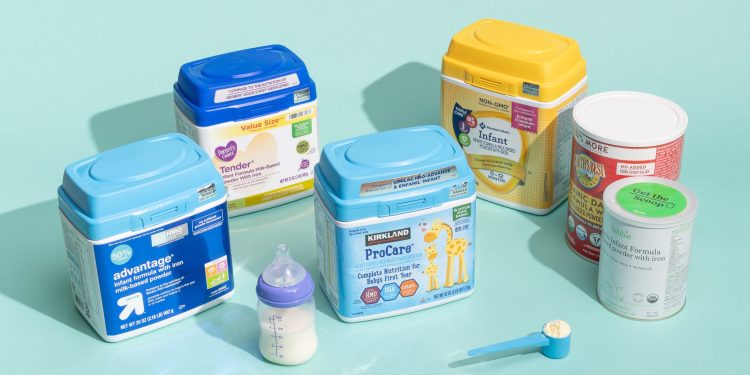Hypoallergenic baby formulas are specially designed to reduce the risk of allergic reactions in infants who may be sensitive to certain ingredients found in regular infant formulas. These formulas are often recommended for babies who have a family history of allergies, eczema, or other allergic conditions. Hypoallergenic formulas are typically made with extensively hydrolyzed proteins or amino acid-based ingredients, which are easier for a baby’s digestive system to tolerate. These formulas are also free from common allergens such as cow’s milk, soy, and lactose, making them a suitable alternative for babies with known or suspected allergies.
Hypoallergenic formulas come in both liquid and powdered forms, and they are available in a variety of options, including ready-to-feed, concentrate, and powder. It is important to note that hypoallergenic formula is not a cure for allergies, but they can help manage symptoms and reduce the risk of allergic reactions in infants. It is always best to consult with a pediatrician before making any changes to a baby’s diet, especially if there are concerns about allergies or intolerances.
Criteria for Selecting the Top Hypoallergenic Baby Formulas
When selecting a hypoallergenic baby formula, there are several important factors to consider. First and foremost, it is crucial to choose a formula that is specifically designed to meet the nutritional needs of infants. Look for formulas that are fortified with essential nutrients such as iron, calcium, and vitamin D, as well as those that contain a balanced blend of carbohydrates, fats, and proteins. Additionally, it is important to consider the form of the formula, as some babies may prefer ready-to-feed options over powdered formulas.
Another important consideration when choosing a hypoallergenic formula is the source of protein. Extensively hydrolyzed formulas are made with proteins that have been broken down into smaller pieces, making them easier for babies to digest. Amino acid-based formulas, on the other hand, contain individual amino acids and are often recommended for babies with severe allergies or intolerances. It is also important to consider any additional dietary restrictions or preferences when selecting a hypoallergenic formula, such as the absence of certain ingredients like soy or lactose.
Top 5 Hypoallergenic Baby Formulas for 2024
1. Similac Alimentum: Similac Alimentum is a popular choice for babies with cow’s milk protein allergy or sensitivity. This extensively hydrolyzed formula is designed to be gentle on a baby’s digestive system and is often recommended by pediatricians for infants with colic or reflux.
2. Enfamil Nutramigen: Enfamil Nutramigen is another widely recognized hypoallergenic formula that is formulated with extensively hydrolyzed proteins to reduce the risk of allergic reactions. This formula also contains DHA and ARA, which are important nutrients for brain and eye development.
3. Gerber Extensive HA: Gerber Extensive HA is an amino acid-based formula that is suitable for babies with severe allergies or intolerances. This formula is free from common allergens such as cow’s milk and soy, making it a safe option for infants with known or suspected allergies.
4. EleCare: EleCare is a medical-grade amino acid-based formula that is often recommended for babies with multiple food allergies or severe gastrointestinal conditions. This formula is designed to provide complete nutrition for infants who require a specialized diet.
5. Baby’s Only Organic LactoRelief: Baby’s Only Organic LactoRelief is a lactose-free formula that is made with organic ingredients and is suitable for babies with lactose intolerance or sensitivity. This formula also contains essential nutrients such as DHA and ARA for healthy growth and development.
Benefits of Hypoallergenic Baby Formulas
Hypoallergenic baby formulas offer several benefits for infants who may be at risk of allergic reactions or intolerances. These formulas are specifically designed to be gentle on a baby’s digestive system, making them an ideal choice for babies with known or suspected allergies. By using extensively hydrolyzed proteins or amino acid-based ingredients, hypoallergenic formula can help reduce the risk of allergic symptoms such as eczema, hives, or gastrointestinal discomfort.
In addition to reducing the risk of allergic reactions, hypoallergenic formulas also provide essential nutrients that are important for a baby’s growth and development. Many hypoallergenic formulas are fortified with key nutrients such as iron, calcium, and vitamin D, as well as important fatty acids like DHA and ARThese nutrients are crucial for brain development, immune function, and overall health in infants.
Furthermore, hypoallergenic formulas can provide peace of mind for parents who may be concerned about their baby’s risk of developing allergies or intolerances. By choosing a hypoallergenic formula that is recommended by a pediatrician, parents can feel confident that they are providing their baby with a safe and nutritious alternative to regular infant formula.
How to Introduce Hypoallergenic Baby Formulas to Your Baby
When introducing a hypoallergenic baby formula to your infant, it is important to do so gradually in order to allow their digestive system to adjust to the new formula. Start by mixing small amounts of the hypoallergenic formula with your baby’s current formula, gradually increasing the ratio of the new formula over the course of several days. This will help minimize any potential digestive discomfort and allow your baby to become accustomed to the taste and texture of the new formula.
It is also important to monitor your baby for any signs of allergic reactions or intolerances when introducing a new formula. Common symptoms of allergic reactions in infants may include rash, hives, vomiting, diarrhea, or excessive fussiness. If you notice any concerning symptoms, it is important to consult with your pediatrician right away.
Additionally, it may be helpful to offer the new formula during times when your baby is most hungry and likely to be receptive to trying something new. By offering the hypoallergenic formula when your baby is hungry and alert, you may increase the likelihood of a successful transition to the new formula.
Potential Risks and Side Effects of Hypoallergenic Baby Formulas
While hypoallergenic baby formulas are generally considered safe and well-tolerated by most infants, there are some potential risks and side effects to be aware of. Some babies may experience mild digestive discomfort when transitioning to a new formula, such as gas, bloating, or changes in stool consistency. These symptoms typically resolve on their own as the baby’s digestive system adjusts to the new formula.
In rare cases, some babies may experience allergic reactions or intolerances to certain ingredients in hypoallergenic formulas. If you notice any concerning symptoms such as rash, hives, vomiting, or excessive fussiness after introducing a new formula, it is important to consult with your pediatrician right away.
It is also important to note that hypoallergenic formulas can be more expensive than regular infant formulas, which may be a consideration for some families. However, many insurance plans may cover the cost of hypoallergenic formulas if they are medically necessary for a baby with known allergies or intolerances.
Making the Best Choice for Your Baby’s Nutrition
In conclusion, hypoallergenic baby formulas can be a valuable option for infants who may be at risk of allergic reactions or intolerances. These specialized formulas are designed to be gentle on a baby’s digestive system and can help reduce the risk of allergic symptoms such as eczema, hives, or gastrointestinal discomfort. When selecting a hypoallergenic formula for your baby, it is important to consider factors such as the source of protein, nutritional content, and any additional dietary restrictions or preferences.
It is always best to consult with a pediatrician before making any changes to your baby’s diet, especially if there are concerns about allergies or intolerances. By working closely with your pediatrician and carefully monitoring your baby’s response to a new formula, you can make an informed decision about the best choice for your baby’s nutrition. Ultimately, the goal is to provide your baby with a safe and nutritious alternative to regular infant formula that meets their individual needs and supports their healthy growth and development.


























